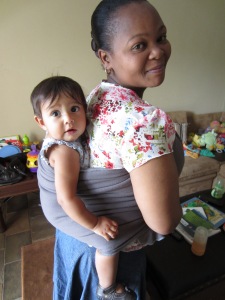
The following is a guest post written by Sarah C. Sell:
Due to recent legislation, Moby Wrap has significantly decreased the number of holds that they recommend be used with their carrier. Prior to 2007, the Moby Instruction Manual showed 10 different holds, making Moby one of the most versatile carriers available. Now, only four holds are shown in the product manual, although Moby has expressed willingness to assist customers with some of the original carry styles, including the front-facing ‘Joey’ hold.
However, Moby no longer officially endorses the back carry, known as the ‘Hike’ hold. The ‘Hike’ hold is very similar to the Kangaroo Wrap and Hold, simply done on the back. Moby ‘recommends front and hip holds that position baby where caregivers can use their sense to observe and interact with their babies and to ensure safe positioning.’
To those of us who are dedicated to back-carrying our babies, though, this reasoning rings false. Just because a mother is carrying her baby on her back does not mean that she is unaware of it. On the contrary, I am hyper-aware of my daughter when I carry her on my back. I can feel every move she makes, as well as how she is sitting and where she is positioned. Every noise she makes reverberates through my body, and I can reach back to feel her, or to hand her toys.
Back-carrying offers a myriad of benefits that front-carrying does not. While front-carrying is appropriate for new babies who are unable to hold their heads up, older babies are capable of riding contentedly on their mothers’ backs, playing with toys or simply observing the world. Back-carrying enables parents to do things like washing dishes, making beds, and doing laundry that are difficult with a squirmy baby tied to the front. This is why pre-industrial cultures throughout the world are known for back-carrying their babies and young children. In agrarian societies, where so much work involves walking, carrying, and bending over, the back-carry is the most practical way to care for infants.
Back-carrying centers the baby on the parent’s hips, which not only helps the parent to bear the weight, but accustoms the child’s body to the movements of walking. As babies get older, they begin to hang on more with their legs, building muscle and tendon strength.

There are many carriers designed for back-carrying. In Africa, either a towel or a rectangular piece of cloth called a kanga is used to hold the baby onto the mother’s back. The ends of the towel or kanga are simply folded together in the front. In South America, a similar cloth is used, but the ends of the cloth are more likely to be tied in a knot. Asian Baby Carriers (ABCs), often seen in China, are panels of cloth with straps used to tie the baby on. In the West, there are many carriers available, including the frame-style backpack carrier, structured carriers like the Ergo Baby, and wrap-style carriers like the Moby.
Like everything in life, baby-carrying has an inherent amount of risk. Depending on the age of the baby and the type of carrier, parents should take certain precautions to ensure their babies’ safety. For many types of back carriers, having another adult near as a spotter while putting the baby onto the back in a good idea, at least until one has practiced enough. For small babies, make sure that the head has enough support and that the airway is not obstructed. With stretchy wraps such as the Moby, extra care is necessary to ensure that the baby does not push itself out, since the material has extra give in it. I do not carry my seven-month-old daughter in the Moby on my back, because I know that she likes to fling herself out. If one has a less-wiggly baby, or an older child who knows better, the Moby can be used as a back carrier. I personally prefer a beach towel as a back carrier. The material does not stretch, and my baby rides happily on my back while I work around the house and run errands.
The bottom line is that back-carrying is safe and effective if common sense is used. The sheer number of women who have carried their babies this way for thousands of years shows that the risk is not unduly high. With so many styles of carrier available, every parent should be able to find one that suits their needs.
Related Pages:
3 thoughts on “Back Carrying: Where East Meets West?”